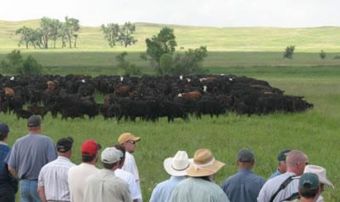Food/Sustainable ranching

In the wild, herbivores huddle close together for protection from predators. In this 'mob', they mow down an area of grass in about a day, then move on to a different patch. The loss of predators has meant that herbivores spread out into extensive grazing patterns, which caused overgrazing and the destruction of the grasslands, which is a greater source of greenhouse gas emissions than all the fossil fuels burnt by industry, prompting authors of a recent paper in Science to say that the loss of predators "may be humankind’s most pervasive influence on nature" [3][4].
With mob-grazing, ranches are managed so that herbivores' natural grazing patterns are restored, allowing the grass to grow the way it evolved to grow. Using light, portable electric fencing, livestock are corralled into a small 'cell' of grass at very high densities. After 1-3 days grazing, the herd is moved to a different cell. Any one area of grass is only grazed a few days per year and spends the rest of the time growing, so there is no overgrazing, despite extremely high densities of livestock.
The benefits of this sort of grazing — for grass, soil, animals and people — are remarkable. Manure fertilizes the grass, the mowing causes the grass to shed some of its roots, which then decompose and further improve the soil, and the animals' hooves break up the hardpan on the surface, further improving the structure of the soil. As mentioned in water-efficient agriculture, mob-grazing has been shown to increase the amount of water soil can hold by 775%. This is particularly needed in sub-Saharan Africa and other places where extensive grazing patterns have made grasslands dry and dead. In areas where cell-grazing has been implemented, grasslands have recovered[5] and the soil and ecosystem holds so much water that drought is no longer a threat[6][7].
Another key advantage is that multiple animals can graze the same pasture in rotation. Polyface Farms grazes cows, turkeys, pigs, chickens, hens and rabbits on the same space by rotating them in time. This further benefits the soil and allows the animals to benefit from one another. For example, the maggots that grow in cow manure are a food source for chickens. Moreover, it obviously allows much higher productivity per unit of land.